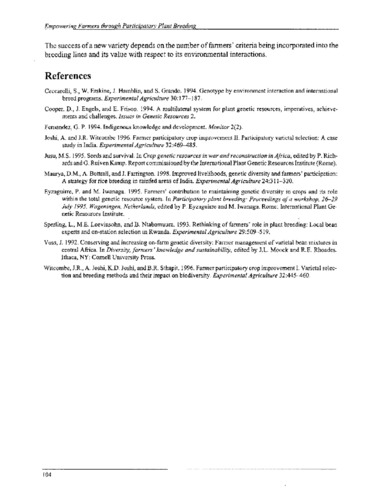Breeding and varietal improvement of cassava in India
An analysis of the recent trend in cassava area, production and yield during 1993-96 revealed an impressive increase in Tamil Nadu, which is the predominant state where cassava is grown as an industrial crop. Its present yield of 29 t/ha is the highest in the world. Even though the overall national trend in cassava area and production is declining, India's current average yield of 21 t/ha is also the world's highest.
In India, cassava breeding is mainly carried out at CTCRI in Thiruvananthapuram and at its regional centre at Bhubaneswar. The All India Co-ordinated Research Project on Tuber Crops, with eleven centres in the country, is also engaged in cassava improvement in a limited way. The Tamil Nadu centre has recently identified a high yielding short duration variety, H-1 19, while the Assam centre has identified two varieties, i.e. H-165 and Sree Prakash, suitable for the region. The co-ordinating centres in Madhya Pradesh and Andhra Pradesh, along with the CTCRI regional centre at Bhubaneswar, have been evaluating the promising exotic germplasm received from the Thai-CIAT program. High root yields of more than 35 t/ha were recorded for some of the CIAT selections, i.e. CMR33-67, CMR36-32, SM2077 and SM2090.
Attention is currently being given to the development of early maturing, good cooking quality varieties, which can be harvested at sixth months, so that they can effectively be utilized in cassava-rice double cropping systems as practised in Kerala. Three short-duration indigenous clones, i.e. CI-649, CI-731 and CI-732, were identified, which are now in the pre-release stage. These varieties are also included in the initial evaluation trial of the All India Co-ordinated Research Project on Tuber Crops.
Breeding efforts are also focused on developing high yielding, high starch varieties for areas like Tamil Nadu, Andhra Pradesh and Madhya Pradesh. A unique approach in this direction is the production of "triploids". The triploids, possessing high yield combined with high starch recovery, hold much promise to become popular in regions like Salem district of Tamil Nadu, where the crop is grown for the starch industry. A triploid, 2/14, has already been proposed for release under the name 'Sree Harsha' by the State Varietal Release Committee.
Studies are also in progress on the possibility of using sexual seed for the rapid propagation and spread of cassava. Results indicate that even unselected first clonal progenies of promising parents have a comparable root yield and dry matter production capacity as those of the high yielding released varieties of cassava.
Cassava mosaic disease is still posing great problems in germplasm conservation. Use of a nursery technique with three noded cuttings coupled with thorough screening and roguing of CMD affected plants in the nursery and field was effective in the recovery and quicker multiplication of symptom-free plants.

